Abstract
The incidence of cancer in children with intellectual disability has been poorly documented. We report our experience of treating children and adolescents with cancer and intellectual disability (40 patients), from 2004 to 2018. A treatment-sparing approach was adopted for 6 patients with severe intellectual impairment to minimize toxicity: a child with postpartum asphyxia and medulloblastoma did not receive radiotherapy; 1 patient with mitochondrial encephalopathy and a testicular germ cell tumor did not receive bleomycin and lung metastasectomy; 2 patients (1 with Down + West syndrome + Wilms tumor (WT) and 1 with Denys-Drash syndrome + WT) did not receive vincristine; 1 child with corpus callosum agenesis and anaplastic ependymoma did not receive chemotherapy; 1 child with structural chromosomal aberrations and a primitive neuro-ectodermal tumor received personalized chemotherapy. Heminephrectomy was performed in 4 patients with WT to preserve their kidney function. We found no statistically significant correlation between relapse or mortality rates and the use of a treatment-sparing approach. The 5-year overall survival (OS) and event-free survival (EFS) rates were 84.5% and 66.1% as opposed to 82.5% and 46.9%, respectively, for patients in our usual-treatment and treatment-sparing groups.
Conclusion: We only opted for a treatment-sparing approach for patients with severe disabilities, and their OS was in line with that of children without intellectual disability.
What is Known: • There are few reports on children/adolescents with cancer and intellectual disability (ID). • It is not clear how to manage them and whether a treatment sparing should be considered, especially in the case of severe disability. | |
What is New: • Most patients received the standard cancer treatment and only in the case of severe disability, a therapeutic saving approach was applied. • No statistically significant correlations between relapse/mortality rates and the use of a treatment-sparing approach were found. |



Similar content being viewed by others
Abbreviations
- ASRE:
-
European age-standardized rate
- EFS:
-
Event-free survival
- ID:
-
Intellectual disability
- OS:
-
Overall survival
- PFS:
-
Progression-free survival
- WAGR:
-
Wilms tumor, aniridia, genitourinary anomalies, and mental retardation
- WT:
-
Wilms tumor
References
Ross J, Olshan A (2004) Pediatric Cancer in the United States: th Children's oncology group epidemiology research program. Cancer Epidemiol Biomark Prev 13(10):1552–1554
Agha MM, Williams JI, Marrett L, To T, Zipursky A, Dodds L (2005) Congenital abnormalities and childhood cancer: a cohort record-linkage study. Cancer 103:1939–1948. https://doi.org/10.1002/cncr.20985
Rankin J, Silf KA, Pearce MS, Parker L, Platt MW (2008) Congenital anomaly and childhood cancer: a population-based, record linkage study. Pediatr Blood Cancer 51(5):608–612. https://doi.org/10.1002/pbc.21682
Merks JHM, Özgen HM, Koster J, Zwinderman AH, Caron HN, Hennekam RCM (2008) Prevalence and patterns of morphological abnormalities in patients with childhood cancer. JAMA - J Am Med Assoc 299(1):61–69. https://doi.org/10.1001/jama.2007.66
Pisani CP, Buzzoni C, Crocetti E et al (2012) AIRTUM working group – AIEOP working group I tumori Dei bambini e degli adolescenti Cancer in children and adolescents AIRTUM working group and AIEOP working group. https://doi.org/10.2337/dc12-s011
(2001) Healthy ageing - adults with intellectual disabilities: summative report. J Appl Res Intellect Disabil. https://doi.org/10.1046/j.1468-3148.2001.00071.x
Roeleveld N, Zielhuis GA (1997) The prevalence of mental retardation: a critical review of recent literature. Dev Med Child Neurol 39(2):125–132. https://doi.org/10.1111/j.1469-8749.1997.tb07395.x
Durkin MS, Hasan ZM, Hasan KZ (1998) Prevalence and correlates of mental retardation among children in Karachi, Pakistan. Am J Epidemiol 147(3):281–288. https://doi.org/10.1093/oxfordjournals.aje.a009448
Sullivan SG, Hussain R, Threlfall T, Bittles AH (2004) The incidence of cancer in people with intellectual disabilities. Cancer Causes Control 15(10):1021–1025. https://doi.org/10.1007/s10552-004-1256-0
Patja K, Eero P, Iivanainen M (2001) Cancer incidence among people with intellectual disability. J Intellect Disabil Res 45(Pt4):300–307. https://doi.org/10.1046/j.1365-2788.2001.00322.x
Satgé D, Sommelet D, Geneix A, Nishi M, Malet P, Vekemans M (1998) A tumor profile in down syndrome. Am J Med Genet 78(3):207–216
Hill DA, Gridley G, Cnattingius S et al (2003) Mortality and cancer incidence among individuals with down syndrome. Arch Intern Med 163(6):705–711. https://doi.org/10.1001/archinte.163.6.705
Hasle H, Haunstrup Clemmensen I, Mikkelsen M (2000) Risks of leukaemia and solid tumours in individuals with Down’s syndrome. Lancet 355(9199):165–169. https://doi.org/10.1016/S0140-6736(99)05264-2
Pritchard-jones K, Renshaw J, King-underwood L (1994) The Wilms tumour (WT1) gene is mutated in a secondary leukaemia in a WAGR patient. Hum Mol Genet 3(9):1633–1637. https://doi.org/10.1093/hmg/3.9.1633
Al-Saleem T, Wessner LL, Scheithauer BW et al (1998) Malignant tumors of the kidney, brain, and soft tissues in children and young adults with the tuberous sclerosis complex. Cancer 83(10):2208–2216. https://doi.org/10.1002/(SICI)1097-0142(19981115)83:10<2208::AID-CNCR21>3.0.CO;2-K
Reynolds RM, Browning GGP, Nawroz I, Campbell IW (2003) Von Recklinghausen’s neurofibromatosis: Neurofibromatosis type 1. Lancet 361(9368):1552–1554
Kratz CP, Franke L, Peters H, Kohlschmidt N, Kazmierczak B, Finckh U et al (2015) Cancer spectrum and frequency among childrten with Noonan, Costello and cardio-facio-cutaneous syndromes. Br J Cancer 112:1392–1397
McWilliams GD, SantaKruz K, Hart B, Clericuzio C (2016) Occurance of DNET and other brain tumors in Noonan syndrome warrant caution growth hormone therapy. Am J Med Genet Part A 170A:195.201
Jongmans MC, van der Burget I, Hoogerbrugge PM, Noordan K, Yntema HG, Nillesen WM et al (2011) Cancer risk in patinets with Noonan syndrome carrying a PTPN11 mutation. Eur J Hum Genet 19:870–874
Kraz CP, Rapisuwon S, Reed H, Hasle H, Rosenberg PS (2011) Cancer in Noonan, Costello, cardiofaciocutaneous and LEOPARD syndromes. Am J Med Genet C Semin Med Genet 157C:83–89
Villani A, Greer MC, Kalish JM, Nakagawara A, Nathanson KL, Pajtler KW, Pfister SM, Walsh MF, Wasserman JD, Zelley K, Kratz CP (2017) Recommendations for Cancer surveillance in individuals with RASopathies and other rare genetic conditions with increased Cancer risk. Clin Cancer Res 23(12):e83–e90. https://doi.org/10.1158/1078-0432.CCR-17-0631
Author information
Authors and Affiliations
Contributions
All authors contributed to the study conception and design. Data collection was performed by Chiara Barteselli and Cristina Meazza; methodology by Cristina Meazza; formal analysis by Francesco Barretta; writing - original draft preparation by Cristina Meazza, Elisabetta Schiavello, Veronica Biassoni, Marta Podda, Giovanna Gattuso; writing - review and editing by Giovanna gattuso, Monica Terenziani, Andrea Ferrari, Filippo Spreafico, Roberto Luksch, Michela Casanova, Stefano Chiaravalli, Nadia Puma, Luca Bergamaschi; supervision by Maura Massimino. All authors read and approved the final manuscript.
Corresponding author
Ethics declarations
Conflict of interest
The authors declare that they have no conflict of interest.
Ethical approval
This article does not contain any studies with human participants or animals performed by any of the authors.
Additional information
Communicated by Peter de Winter
Publisher’s note
Springer Nature remains neutral with regard to jurisdictional claims in published maps and institutional affiliations.
Rights and permissions
About this article
Cite this article
Meazza, C., Schiavello, E., Biassoni, V. et al. Cancer treatment in disabled children. Eur J Pediatr 179, 1353–1360 (2020). https://doi.org/10.1007/s00431-020-03607-6
Received:
Revised:
Accepted:
Published:
Issue Date:
DOI: https://doi.org/10.1007/s00431-020-03607-6




